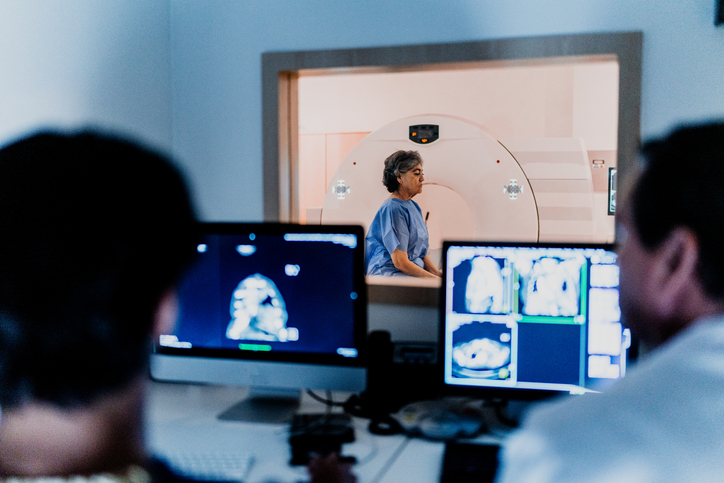Can an MRI Tell If a Tumor Is Benign?

If you’ve recently been told you need an MRI because of a possible tumor, you might be wondering if this scan can tell you whether it’s benign (non-cancerous) or malignant (cancerous). It’s a common question. Let’s look into what an MRI can do, how it works, and whether it can give you a clear answer about the nature of a tumor with help from our research and talented team of doctors.
What Is an MRI, and How Does It Work?
An MRI (Magnetic Resonance Imaging) is a high-tech tool doctors use to see inside your body. Instead of using radiation like an X-ray, an MRI relies on powerful magnets and radio waves to create detailed images of your organs and tissues. These images can show anything unusual, like a tumor, in more detail than other types of scans.
Here’s what makes MRIs special:
- Clear, detailed images: MRIs provide sharp, high-resolution images of your organs, making it easier to spot abnormalities.
- Great for soft tissue: They’re especially good at picking up on soft tissue issues, like those in the brain, spine, or liver.
- Safe and non-invasive: MRIs don’t use harmful radiation, so they’re considered safe for most people.
How MRIs Determine If a Tumor Is Benign

Now, let’s get to the big question: Can an MRI tell if a tumor is benign? The short answer is—kind of.
An MRI can show if there’s a tumor and give clues about whether it’s benign or malignant. Radiologists, the doctors who read these scans, look for certain signs. For example, benign tumors often have smooth, well-defined edges, while malignant ones can appear jagged or irregular. But here’s the catch: these clues aren’t always 100% reliable.
To know for sure if a tumor is benign or malignant, you’ll likely need additional tests, like a biopsy. This involves removing a small sample of the tumor tissue to examine it under a microscope.
Common Tumors Detected by MRI
MRIs are commonly used to detect various tumors. Here’s a breakdown of some of the most frequent types:
1. Brain Tumors
When it comes to brain tumors, MRIs are the go-to method for spotting them. They can help distinguish between more common benign brain tumors, like meningiomas, and malignant ones, like gliomas. But even with these scans, a biopsy is usually necessary for a firm diagnosis.
2. Breast Tumors
While mammograms are the first step for detecting breast tumors, MRIs offer extra information, especially for women with dense breast tissue. However, you’ll still need further tests to confirm if a tumor is cancerous.
3. Spinal Tumors
MRIs are excellent for spotting tumors in the spine. They can give your doctor a good idea of whether the tumor is benign or malignant based on its appearance and location, but, again, a biopsy is typically needed to confirm.
What Happens After an MRI Finds a Tumor?
Finding a tumor on an MRI can feel scary, but remember: not all tumors are dangerous. Once the MRI detects a tumor, your doctor will recommend the next steps. This could involve additional imaging, blood tests, or, most commonly, a biopsy. The biopsy will provide a clear answer about whether the tumor is benign or malignant.
In some cases, your doctor might suggest keeping an eye on the tumor through regular follow-up MRIs. If it grows or changes, more action might be needed.
Learn More About Tumor Diagnosis and MRI Scans
Understanding whether a tumor is benign or malignant is a vital first step in receiving the right treatment. While MRIs offer powerful diagnostic insights, a dedicated medical team's expert care and guidance make the biggest difference in your journey.
At The Preston Robert Tisch Brain Tumor Center, our team is here to support you every step of the way. We’re committed to providing the best care possible, from cutting-edge imaging to personalized treatment plans. Whether you’re dealing with a benign or malignant tumor, you can trust us to guide you through the process with compassion and expertise.
Ready to take the next step? Schedule an appointment with our team today to learn more about your options for tumor diagnosis and treatment.
Interested in joining the team of world-leading Neuro-Oncology doctors and practitioners? Visit our education & training page to learn more. You can also support the clinic by donating funds directly to patient care, research, education, and treatment for brain tumors.
Want to learn more about brain tumor care? Explore related articles on our blog:
- Do Brain Tumors Show Up In Blood Work?
- Diet and Nutrition for Brain Tumor Patients
- What is the Best Treatment for Brain Cancer: Unraveling the Options
FAQ: Tumor Diagnosis and MRI Scans
Can an MRI tell if a tumor is benign or malignant?
An MRI can provide clues, but it can't definitively tell if a tumor is benign or malignant without further testing like a biopsy.
Which is better for finding cancer, CT or MRI?
Both scans are useful, but MRIs are typically better for detecting soft tissue cancers, while CT scans are often used for detecting cancers in bones and lungs.
Can an MRI tell the difference between a cyst and a tumor?
Yes, an MRI can usually differentiate between a cyst, which is fluid-filled, and a solid tumor based on its appearance in the images.
Can a doctor tell if a tumor is malignant without a biopsy?
Doctors may have an idea based on MRI results and other tests, but a biopsy is the most reliable way to confirm if a tumor is malignant.
What is the best scan to detect cancer?
The best scan depends on the cancer type. MRIs are great for soft tissue cancers, while CT scans or PET scans may be better for others.
Can MRI results be seen immediately?
While the MRI images are generated right away, a radiologist needs time to interpret them. Results are typically available within a few days.